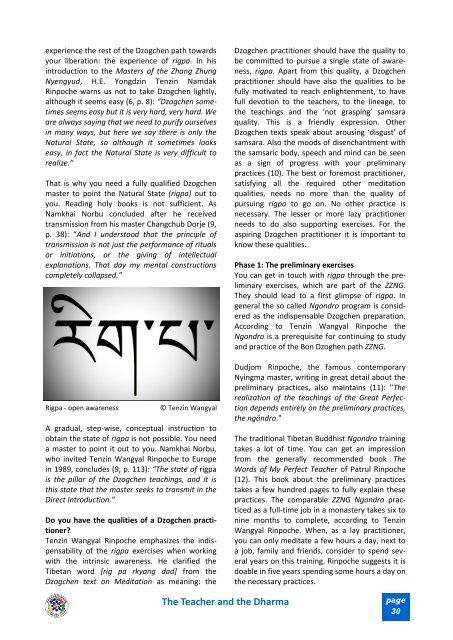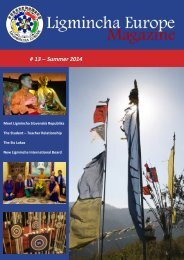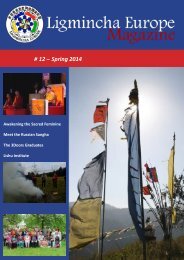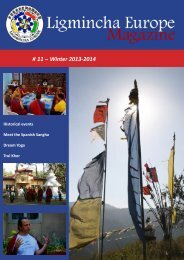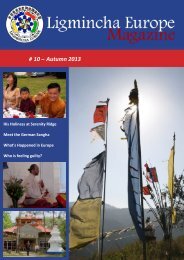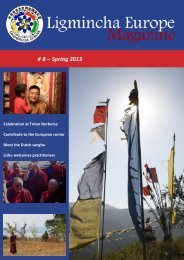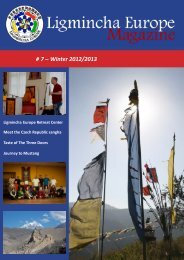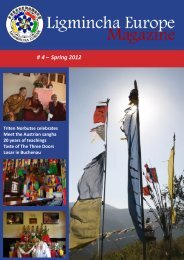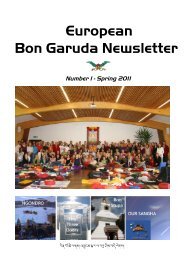Ligmincha Europe Magazine # 9 – Summer 2013
European Magazine of the Ligmincha Sangha of Tenzin Wangyal Rinpoche. Informs about news, events, teachings and projects within the Bon-Buddhist Sangha.
European Magazine of the Ligmincha Sangha of Tenzin Wangyal Rinpoche. Informs about news, events, teachings and projects within the Bon-Buddhist Sangha.
You also want an ePaper? Increase the reach of your titles
YUMPU automatically turns print PDFs into web optimized ePapers that Google loves.
experience the rest of the Dzogchen path towards<br />
your liberation: the experience of rigpa. In his<br />
introduction to the Masters of the Zhang Zhung<br />
Nyengyud, H.E. Yongdzin Tenzin Namdak<br />
Rinpoche warns us not to take Dzogchen lightly,<br />
although it seems easy (6, p. 8): “Dzogchen sometimes<br />
seems easy but it is very hard, very hard. We<br />
are always saying that we need to purify ourselves<br />
in many ways, but here we say there is only the<br />
Natural State, so although it sometimes looks<br />
easy, in fact the Natural State is very difficult to<br />
realize.”<br />
That is why you need a fully qualified Dzogchen<br />
master to point the Natural State (rigpa) out to<br />
you. Reading holy books is not sufficient. As<br />
Namkhai Norbu concluded after he received<br />
transmission from his master Changchub Dorje (9,<br />
p. 38): “And I understood that the principle of<br />
transmission is not just the performance of rituals<br />
or initiations, or the giving of intellectual<br />
explanations. That day my mental constructions<br />
completely collapsed.”<br />
Rigpa - open awareness © Tenzin Wangyal<br />
A gradual, step-wise, conceptual instruction to<br />
obtain the state of rigpa is not possible. You need<br />
a master to point it out to you. Namkhai Norbu,<br />
who invited Tenzin Wangyal Rinpoche to <strong>Europe</strong><br />
in 1989, concludes (9, p. 113): “The state of rigpa<br />
is the pillar of the Dzogchen teachings, and it is<br />
this state that the master seeks to transmit in the<br />
Direct Introduction.”<br />
Do you have the qualities of a Dzogchen practitioner?<br />
Tenzin Wangyal Rinpoche emphasizes the indispensability<br />
of the rigpa exercises when working<br />
with the intrinsic awareness. He clarified the<br />
Tibetan word [rig pa rkyang dad] from the<br />
Dzogchen text on Meditation as meaning: the<br />
The Teacher and the Dharma<br />
Dzogchen practitioner should have the quality to<br />
be committed to pursue a single state of awareness,<br />
rigpa. Apart from this quality, a Dzogchen<br />
practitioner should have also the qualities to be<br />
fully motivated to reach enlightenment, to have<br />
full devotion to the teachers, to the lineage, to<br />
the teachings and the ‘not grasping’ samsara<br />
quality. This is a friendly expression. Other<br />
Dzogchen texts speak about arousing ‘disgust’ of<br />
samsara. Also the moods of disenchantment with<br />
the samsaric body, speech and mind can be seen<br />
as a sign of progress with your preliminary<br />
practices (10). The best or foremost practitioner,<br />
satisfying all the required other meditation<br />
qualities, needs no more than the quality of<br />
pursuing rigpa to go on. No other practice is<br />
necessary. The lesser or more lazy practitioner<br />
needs to do also supporting exercises. For the<br />
aspiring Dzogchen practitioner it is important to<br />
know these qualities.<br />
Phase 1: The preliminary exercises<br />
You can get in touch with rigpa through the preliminary<br />
exercises, which are part of the ZZNG.<br />
They should lead to a first glimpse of rigpa. In<br />
general the so called Ngondro program is considered<br />
as the indispensable Dzogchen preparation.<br />
According to Tenzin Wangyal Rinpoche the<br />
Ngondro is a prerequisite for continuing to study<br />
and practice of the Bon Dzoghen path ZZNG.<br />
Dudjom Rinpoche, the famous contemporary<br />
Nyingma master, writing in great detail about the<br />
preliminary practices, also maintains (11): "The<br />
realization of the teachings of the Great Perfection<br />
depends entirely on the preliminary practices,<br />
the ngöndro."<br />
The traditional Tibetan Buddhist Ngondro training<br />
takes a lot of time. You can get an impression<br />
from the generally recommended book The<br />
Words of My Perfect Teacher of Patrul Rinpoche<br />
(12). This book about the preliminary practices<br />
takes a few hundred pages to fully explain these<br />
practices. The comparable ZZNG Ngondro practiced<br />
as a full-time job in a monastery takes six to<br />
nine months to complete, according to Tenzin<br />
Wangyal Rinpoche. When, as a lay practitioner,<br />
you can only meditate a few hours a day, next to<br />
a job, family and friends, consider to spend several<br />
years on this training. Rinpoche suggests it is<br />
doable in five years spending some hours a day on<br />
the necessary practices.<br />
page<br />
30


